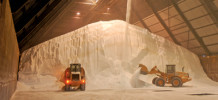An ‘N’ Perspective

Nitrogen fertilizers seem stuck on a price high and supply low these days, as end-users have toggled between anhydrous ammonia (NH3) and urea to gain any possible price advantage in the market. Mark Palmquist, executive vice president and chief operating officer, Ag Business, at CHS Inc., shared some reflections on the 2007 season and his outlook on 2008 in a recent interview.
Q. Give us a little background on nitrogen this year.
Nitrogen usage this spring was probably a little bit higher than people anticipated. But more importantly, demand was stronger and the supply chain didn’t do a good job of adjusting this fall, and did not ramp it up soon enough. Then there was the increase in corn acres up to 92.5 million, and great developments in wheat prices going higher.
End-users ordered late, and because nitrogen prices were high, they did not want to build up big inventory. A lot of people remembered the year prior where nitrogen prices crashed on them in the spring, so they did not want to store a lot of product. It was one of those perfect storms where you had three major events coming together that got the market behind on nitrogen.
Q. And there was no relief on the global production side?
The safety valve in the export market wasn’t there. We literally did not have vessels coming in for more than 30 days, so there was no imported supply to tap into. It was a supply chain issue that got aggravated by demand being a little higher than what was anticipated.
Q. What’s the market like this fall?
We’ve been struggling to fill fall orders, but we hope to get a pickup in imports to help us deal with the tight urea supply. With anhydrous, I’m not sure there is a lot we can do. Production levels are pretty much maxed out at this point. And if you look at UAN, that is definitely maxed out — UAN bothers us the most, and we have been trying to find some solutions but there’s nothing in sight in the short term.
Q. How are current crop prices affecting the future outlook?
Price action between corn, beans, and wheat, if they stay where they are, would suggest that corn acreage would actually go down. So, that’s kind of stopped everybody for a moment to try and figure out how much length they want to build up in urea. We are hoping the market is going to adjust itself because we wouldn’t like to see the corn acreage come down. The price action today shows that wheat prices are almost double that of corn, so that tells you we are going to get an increase in wheat acreage. And if you look at the spread relationship between corn and beans, it says we would also be buying bean acres.
There is still time for the market to readjust — we’re talking about the next 3 months we have got to get that price relationship readjusted to hold on to the corn acres. A lot of producers will be making their decisions by December.
Q. What else do you see, going into 2008?
From a nitrogen standpoint we need to build up supply, and we are trying to get more of the product in position, almost pre-positioned so we can smooth out the supply chain a little bit. Part of the volatility on all crop nutrients has been made worse by a supply chain that has been very herky-jerky, so we are going to smooth that out and pull a little of the volatility out. We think that we can make some inroads on that on the nitrogen side.
We will look at importing some more urea internationally, and honestly that’s one of the positive things we see about crop nutrients coming into CHS is that we have the expertise, we have ocean vessels so we can turn that spigot on a little faster than what was done in the past.
We certainly want to go after anhydrous, so we are sitting down with a lot of our suppliers and asking if there is something that we can do in storage, pre-positioning, and prepayments so that we can get the supplies in place a little bit quicker.
On the UAN side, that is a tight situation and I am not sure what we can do to affect that over the fall and winter — that’s more than a year down the road. And we are looking at adding storage capacity so we can take shipments all year round.
Internationally, demand is going up, but as they say in commodities markets, the best cure for high prices is high prices. It’s creating demand that is raising production. The additional capacity coming in should hit us around 2010 or 2011 and should make the urea situation get more in balance. It’s getting through the next 18 months to 2 years that is really the battle.






